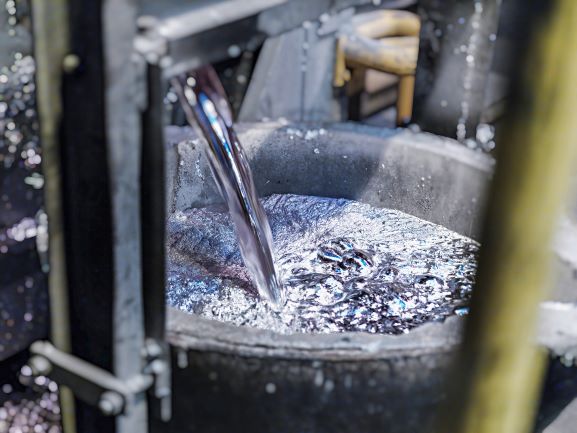– Casting –
optimally matched material properties
We know our way around alloys. For billet production in the speciality foundry, we incorporate our metallurgical know-how and match the materials used in the alloy mix to the desired properties.

Foundry
Our billet foundry at the Satu Mare site in Romania is one of the most modern remelting plants in Europe with a capacity of 44,000 t/year. Our foundry uses a gas-fired 85 t 2-chamber melting furnace and a 32 t holding and alloying furnace. For the production of 5″ to 12″ aluminium billets we use a production process from Cometall Engineering SpA in Italy that is similar to HOT-TOP technology. This process allows us to make billets with thin margin zones and above-average surface quality. Automatically controlled casting, homogenisation and cooling processes ensure high process reliability for consistently good quality at a competitive price.
Alloys and quality
In our speciality foundry, we mainly cast wrought alloys of the families 3xxx and 6xxx, but all other classes (1xxx, 2xxx, 5xxx and 7xxx) are also possible upon request.
We advise our customers on the selection of suitable alloys. We have also been developing customised compositions for decades, such as crash alloys for the automotive industry. All necessary test certificates are included in the service to our customers. Our foundry is certified according to ISO 9001 and ISO/TS 16949. A standardised casting and control process ensures excellent quality, which is verified through frequent metallographic examinations, such as chemical composition analysis, macro and micro analysis and, upon request, ultrasonic testing.
|
Melting furnace capacity
|
85 tonnes
|
|---|---|
|
Casting furnace capacity
|
32 tonnes
|
|
Production capacity per year
|
44,000 tonnes
|
|
Standard formats
|
5“, 7“, 8“, 9“, 12“
|
|
Final billet length
|
Up to 7,500 mm
|
|
Alloys
|
1xxx, 2xxx, 3xxx, 5xxx, 6xxx, 7xxx
|
|
Composition of raw material
|
Approx. 20% primary aluminium, 80% scraps
|
Step by step to a high-quality aluminium billet
Primary aluminium and sorted scraps are liquefied in the 85 t melting furnace at about 720 °C and corrected to the desired alloy in the 32 t alloying furnace by adding further elements.
An automatic skimming machine removes rising slag.
The finished aluminium billets undergo heat treatment to achieve the desired properties of the metal. 2 homogenising furnaces and a cooling chamber are available for this purpose. Strict adherence to narrow temperature tolerances as well as cooling rates lead to the desired strength and a microstructure that is as uniform as possible.
The finished billets are ready for further processing in the extrusion plant.
The liquid aluminium solidifies on the wall and bottom of the mould and forms a solid peripheral zone. The bottom sinks slowly (by 3 to 20 cm/min, depending on the dimensions and alloy), while melt flows steadily to maintain a constant level in the mould. A several metres long aluminium billet is produced. The beginning and end of the billet are cut to a length of 7.5 metres.
The liquid alloy is poured over a casting table with vertically arranged openings (Ø 5" to 12"). The aluminium flows via the cylindrical openings into the shaping, water-cooled moulds. A lowerable platform, which is mounted on a large hydraulic cylinder, lowers the solidified billets at a constant speed.
For perfect billet quality, the liquid aluminium must be as clean and homogeneous as possible before casting—without inclusions or impurities.
An inline degassing system from PYROTEC reduces impurities and the hydrogen content in the alloy.
The downstream ceramic foam filter (CFF) removes even the finest oxides.
